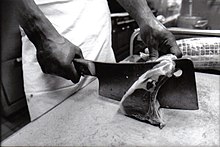Cleaver
As a chopping knife (also cleaver , chopping or Haubeil ) is called special knives in food production.
shape
The knives differ greatly in length and weight depending on the intended use. The rectangular blades have a usual length of 30 to 40 centimeters and a width of 7 to 15 centimeters. The handles can be up to 50 centimeters long. They weigh between 400 and 3000 grams. Although they are sometimes referred to as hatchets, they lack the typical handle, as the blade is firmly connected to a knife handle. The Swiss hatchet is a special form in which the blade is perpendicular to the knife handle.
Uses
In artisanal meat production, knives are used to cut the bodies of slaughtered cattle along the spine, which is done by sawing in industrial production. That is why they are often called slaughterhouse splitters or separation splitters. Smaller knives are used to cut large pieces of meat such as ribs or chops , but also to cut up smaller animals such as lamb , veal and rabbit . Since they are often used in the meat trade, they are also called shop or counter cleavers (from meat counter).
Cleaver in other cultures
The main cleaver used in Japan is the Deba Bocho , which is used to cut off fish heads. Such a cleaver is not used with a chopping knife, but rather the cutting edge is placed on the material to be cut and the back of the blade is struck with a fist or a piece of wood. For processing meat with bones and in butcher shops, heavier cleavers are used, which have a similar effect to Western cleavers.
In both Japanese and Chinese cuisine, knives are incorrectly referred to as chopping knives. Although they are similar in shape, they are considerably thinner and therefore not suitable for cutting through bones. An example is the Nakiri bōchō (Japanese paring knife), which is used for cutting boneless meat, for chopping, cutting and chopping vegetables and at the same time as a scraper to transport the prepared food into the wok.
Industrial knife
In wood processing , knives for rough processing of wood are known as chopping knives, for example to mechanically shred pieces of wood into wood chips .
literature
- Meat processing. VEB Fachbuchverlag Leipzig, 1978.
Individual evidence
- ↑ Hackmesser ( Memento from April 11, 2019 in the Internet Archive ) from tkmgroup.com
